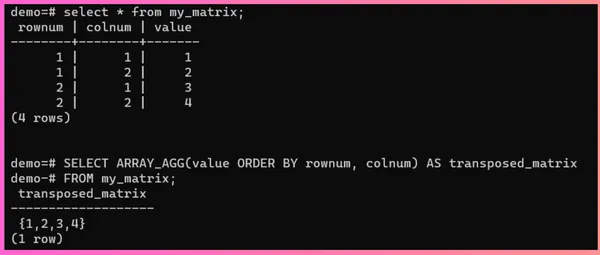Working with matrices in PostgreSQL opens a world of possibilities for managing structured data. Whether you’re dealing with scientific data, financial models, or any other multidimensional datasets, PostgreSQL provides powerful tools and techniques to store, manipulate, and query matrices efficiently.
Matrices consist of arrays organized in a two-dimensional plane to store data in rows and columns. As a result, they operate much like arrays do within PostgreSQL. (Check our guide to learn more about using arrays in Postgres.)
This guide will walk you through the essentials of working with matrices in PostgreSQL.
Creating a matrix in Postgres
As we mentioned, matrix is just a 2-D array, therefore you can use the ARRAY constructor to create a matrix in Postgres. Here’s an example of 2x2 matrix:
SELECT ARRAY[ARRAY[1, 2], ARRAY[3, 4]] AS matrix1;

In this example, we have used 2 ARRAY constructors (ARRAY[1,2], ARRAY[3,4]) inside of an ARRAY constructor. matrix1 is the name of the column holding this matrix.
Matrix Storage in Tables
In Postgres it’s possible to use “matrix” as a data type for a column in a table. You can create a column in the table and store matrix format data in it, like this:
CREATE TABLE matrix_table (
id serial PRIMARY KEY,
data INT[][]
);
In this example, the data column is of type integer matrix, but you can use any data type as the element type when defining matrices.
Once your matrix is created, you can follow the traditional method to insert values into it:
INSERT INTO matrix_table (data)
VALUES (ARRAY[ARRAY[1, 2, 3], ARRAY[4, 5, 6]]);
Accessing elements
You can also specify each element present in the matrix individually by specifying the row and column indices for that element. For example:
SELECT data[2][1] FROM matrix_table;

In this example, we have specified the row index 2 and column index 1.
Operations on Matrices
Postgres does not come with built-in functions to perform operations on matrices, so defining matrix operations can be quite verbose. In general, to operate efficiently on matrices, we recommend creating custom SQL and PL/SQL functions.
Here’s an example of a function to add two matrices of size 2 by 2:
CREATE FUNCTION add_matrices(matrix1 INT[], matrix2 INT[])
RETURNS INT[] AS $$
DECLARE
result INT[];
BEGIN
result := ARRAY[ARRAY[matrix1[1][1] + matrix2[1][1], matrix1[1][2] + matrix2[1][2]],
ARRAY[matrix1[2][1] + matrix2[2][1], matrix1[2][2] + matrix2[2][2]]];
RETURN result;
END;
$$ LANGUAGE plpgsql;
Matrix manipulation
PostgreSQL includes some array functions that can be used to manipulate matrices. For example, you can use the ARRAY_AGG function to transpose a matrix:
SELECT ARRAY_AGG(value ORDER BY rownum, colnum) AS transposed_matrix
FROM my_matrix;

Here, ARRAY_AGG is an array function that we have applied on a matrix to perform the operation. However it’s important to know that not every array function will work on matrices. To see a comprehensive list of array functions and operators, see the official PostgreSQL documentation.
Conclusion
In this guide, we explored the matrices and how you can work with them in Postgres.
Struggling to connect Postgres to your project? We’re here to help. Have a look at our guides guides for more ideas and assistance in working with Postgres.
